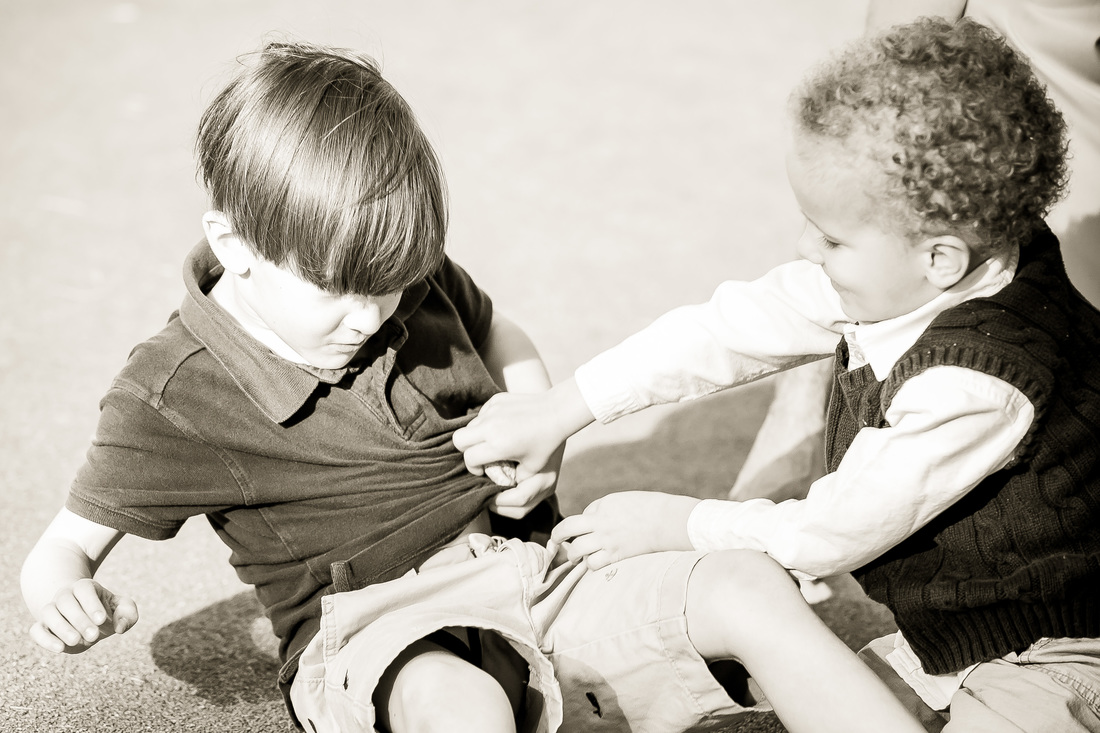|
On a fairly regular basis, I can hear my boys (ages eleven, nearly ten, and almost eight) screaming at each other down in the basement while they are “playing” with each other. I often ask myself the following automatic questions: “Should I go down and see what’s going on?” Or, “Is that an ‘I’m hurt’ scream or an ‘I’m mad’ scream?” More recently, I have begun asking myself, “What kinds of things do my boys need to learn right now besides not hitting or hurting each other?”
Confirmed by academic research, as parents, we tend to interfere in our children’s more intense (usually physical) conflicts with each other. This seems natural for both mothers and fathers, but could parent intervention have greater benefits beyond solely preserving our children's physical well-being? To explore how to answer this fundamental question about parent intervention, we investigate one research study by Perlman and Ross (1997), which focuses on parent intervention in sibling conflict between pairs of preschool-aged siblings. While this research remains focused on a younger preschool-aged population, the ideas and principles about parent intervention may also cross over into slightly older child populations. See parent-led mediation studies of Siddiqui and Ross (2004), Smith and Ross (2007), and Ross and Lazinski (2014) for specific methods of constructive parent intervention in sibling conflict between three to eleven-year-old children. Perlman, Michal, and Hildy S. Ross. 1997. “The Benefits of Parent Intervention in Children’s Disputes: An Examination of Concurrent Changes in Children’s Fighting Styles.” Child Development 68, no. 4 (August): 690-700. Knowing that most sibling conflict is frequent, sometimes quite aggressive, regularly left unresolved, and often ignored by parents, Perlman and Ross (1997) investigated the influence of parent intervention in preschool-aged children’s fights with their siblings. Perlman and Ross’ fundamental research questions included:
Summary of Research To answer these questions, Perlman and Ross investigated the impact of parent intervention on the quality of children's conflict behavior using observational data from 40 English-speaking, two-parent Canadian families with two and four-year-old children. Studying a total of 2, 2271 conflicts, researchers found that sibling fights occurred an average of 57 times in each family or 6.3 times per hour. Parents intervened in approximately 57% of all conflicts while children ended 969 or approximately 42% of their sibling conflicts independently. In this study, Perlman and Ross found that parent intervention in sibling conflict not only tended to decrease conflict intensity, but also facilitated more constructive patterns of conflict management between fighting children. In short, Perlman and Ross’ research suggests that children-especially young children--BENEFIT from parent intervention in sibling conflict. In-depth Investigation of Research Results from Perlman and Ross 1997 To introduce their research study, Perlman and Ross first discuss prevailing beliefs about parent intervention in sibling conflict. Moving beyond Dreikurs’ (author of 1964 best-selling parenting book: Children the Challenge) blanket call to ignore all sibling conflict, we see there are nuances and caveats to blanket style approaches to sibling conflict. Perlman and Ross acknowledge the key beliefs underlying parents choices to either ignore or intervene in sibling conflict. These key beliefs include the following: Key Belief about the Benefits of Ignoring Sibling Conflict Most benefits for ignoring sibling conflict hinge on the idea that siblings are physically, psychologically, and mentally equal so that children jointly discover other options besides fighting for resolving differences. (Rarely, do children fight as true equals in terms of physical, psychological, and mental capabilities). Key Belief about the Benefits of Intervening in Sibling Conflict Parent intervention may help balance power between siblings who may not be physically, psychologically, or mentally equal and who may lack important conflict resolution skills that would allow for constructive conflict resolution. Counteracting a common argument that parent intervention might unfairly bias conflict resolution results, research by Ross, Filyer, Lollis, Perlman, & Martin 1994 suggests that parents do not usually intervene in biased ways to their children’s conflicts with each other. This same research claims that sibling conflict outcomes are more equitable and there is more adherence to family rules when parents do intervene in sibling conflict. What did Perlman and Ross Observe about Parent Intervention in Sibling Conflict? Perlman and Ross observed and analyzed thousands of conflict tactics and skills used by children and parents in this study. To answer the first question about parent motivation for intervention, Perlman and Ross observed the following: What Types of Fights Motivate Parents to Intervene?
Do Fights Change When Parents Intervene? Children’s fights did change when parents intervened in sibling conflict. Perlman and Ross observed the following differences when comparing the length of conflicts, conflict tactics, and differences between older and younger siblings with or without parent intervention: Observations of Sibling Conflict without Parent Intervention
Observations of Sibling Conflict with Parent Intervention
Observations Comparing Fighting Styles Between Two and Four-Year-old's In addition, researchers also observed important differences between fighting styles between two and four-year-old's. Four and two-year-old's tended to use physical power at similar rates, but fight differently in other important ways based on parent intervention. With parent intervention four-year-old's tended to:
Without parent intervention, two-year-old's tended to oppose their older siblings more often, but justified themselves less than with parent intervention. Considering these key differences in older and younger siblings’ fighting styles, we can see that even preschool-aged children are not necessarily fighting as equals. This implies that younger siblings may need some type of scaffolding or support from parents to be able to effectively resolve differences with their more verbally expressive and mature siblings. Overarching Benefits of Parent Intervention in Sibling Conflict for Family Unity and Understanding As Perlman and Ross (1997) state in their article: “for this sample of Caucasian, two-parent families, intervention seemed to both decrease the level of intensity of conflicts and allow the children to behave in ways that are more sophisticated than what they were capable of on their own (699).” Benefits for Parents:
Benefits for Children:
Possible Explanations for Benefits of Parent Intervention in Sibling Conflict While parents are three times as likely to ignore sibling conflict as to intervene in their children’s conflicts with each other, in this 1997 study, parent intervention appears to have positively influenced children’s chosen fighting styles and decreased conflict intensity. Perlman and Ross provide three possible explanations for why parent intervention may positively influence conflict outcomes between preschool-aged siblings. These three possible reasons include: Moral Internalization: When parents intervene, they may encourage children to use inductive-reasoning discipline techniques to directly teach their children the harmful and beneficial consequences of their behavior on others. (Consider the doubling of conflict “moves” with parent intervention). Modeling Constructive Conflict Management Skills: If parents intervene constructively, children may choose to follow their parents’ behavioral strategies. Scaffolding: Given developmental differences between siblings, parents help structure sibling conflict in a way that deescalates conflict and focuses on elaboration and other-oriented reasoning, which facilitates constructive conflict management. Example of Intervening in a Child’s Conflict: Yesterday morning, my six-year-old woke up with the post-Halloween candy blues. Grumpy, ornery, and willing to dish out venom to anyone who provoked her, my boys and I attempted to eat our breakfast in peace; using the classic Dreikurs’ method of ignoring her attempts to engage her brothers in a fight. While we can always hope that negative vibes will somehow dissipate on their own, this may not always work as effectively as we’d like. Yet, despite our collective attempts to ignore Lucie’s unprovoked, continuing outburst, we did not find peace in ignoring her as she crawled under the table and continued ranting. She writhed on the floor beneath our kitchen table in an apparent attempt to provoke our ire; trying to ignite sibling conflict. Unwilling to fight her, my sons and I looked at each other in wonderment. How could we return to eating our breakfast in peace without just ignoring her or banishing her to her room? Those options had not worked so far. Given her mood, I could tell that she needed to be separated from the boys who she could easily try to attack. In a way, her mood influenced her towards trying to pick a fight without any real existing conflict issue like fairness, privileges, or entitlement. In short, I could tell that this was not a sibling conflict situation, but an indication of one child’s need for teaching and de-escalation of intense emotion. Recognizing that ignoring Lucie yielded little fruit, I gently pulled her out from under the table and held her in my arms. I carried her away from the kitchen area to a nearby couch where we could talk. I carefully asked her how she was doing and asked her to come with me to get dressed for school. While certainly not in the mood to calmly talk things through, Lucie at least began to listen somewhat. As we talked through how to speak politely with each other, she did not immediately calm down or address me politely. However, I took the opportunity to teach her how to talk with others, even when she’s grumpy. I emphasized that we all have different moods, but we temper our moods to help others and ourselves get through each day. While I chose to separate Lucie temporarily from her siblings, I took the time to teach her about how to speak with both me and her brothers. We could discuss, in simple terms, what is polite and what is not polite. Rather than merely censure her for impolite behavior, I could invest in teaching her appropriate behavior. Rather than allowing her to provoke her siblings, I could deescalate potential conflict before she ignited conflict based primarily on a lack of sleep and grumpiness. In sum, I tried to put the fire out before it spread throughout the family. No one parenting situation looks exactly alike, but each of us encounter situations that demand our willingness to truly teach, rather than ignore, mandate obedience, or merely punish our children. There may be times like our post-Halloween morning to intervene, separate, teach, and then teach some more. Perhaps, rather than ignoring, we can engage constructively, then slowly pull away as our children learn more effective, sophisticated conflict management strategies.
1 Comment
|
Emily de Schweinitz Taylor
|


 RSS Feed
RSS Feed
